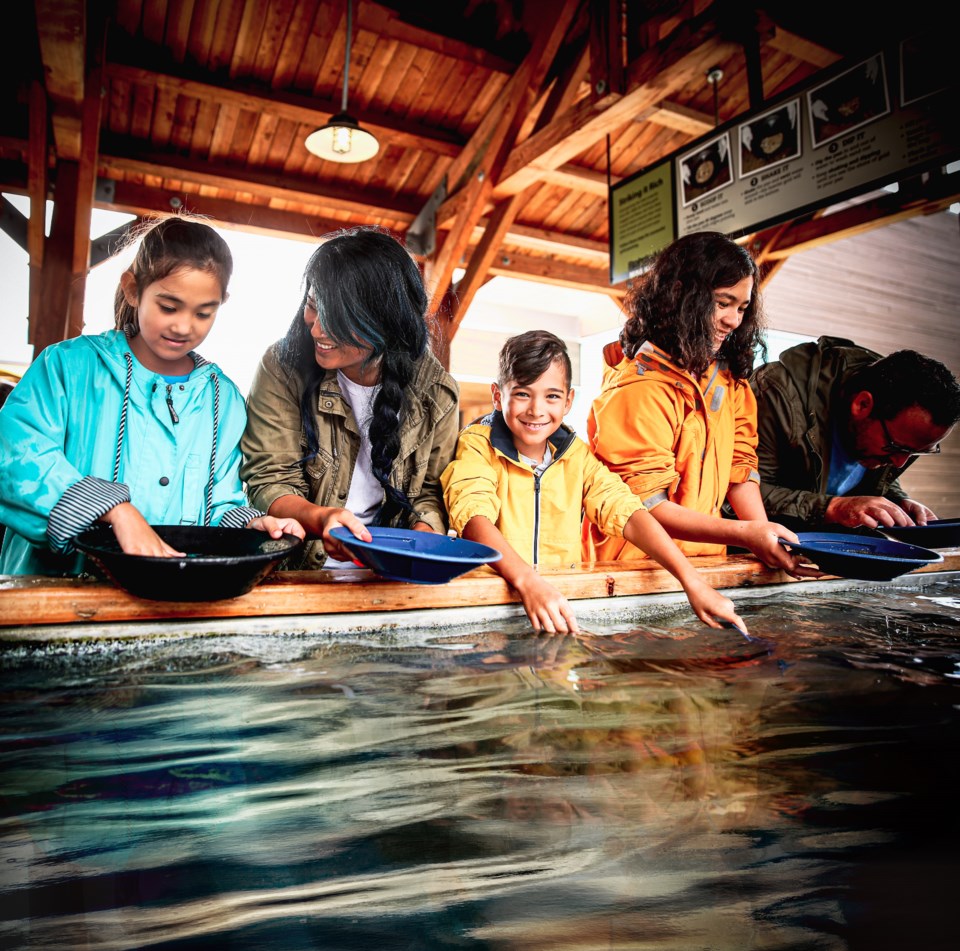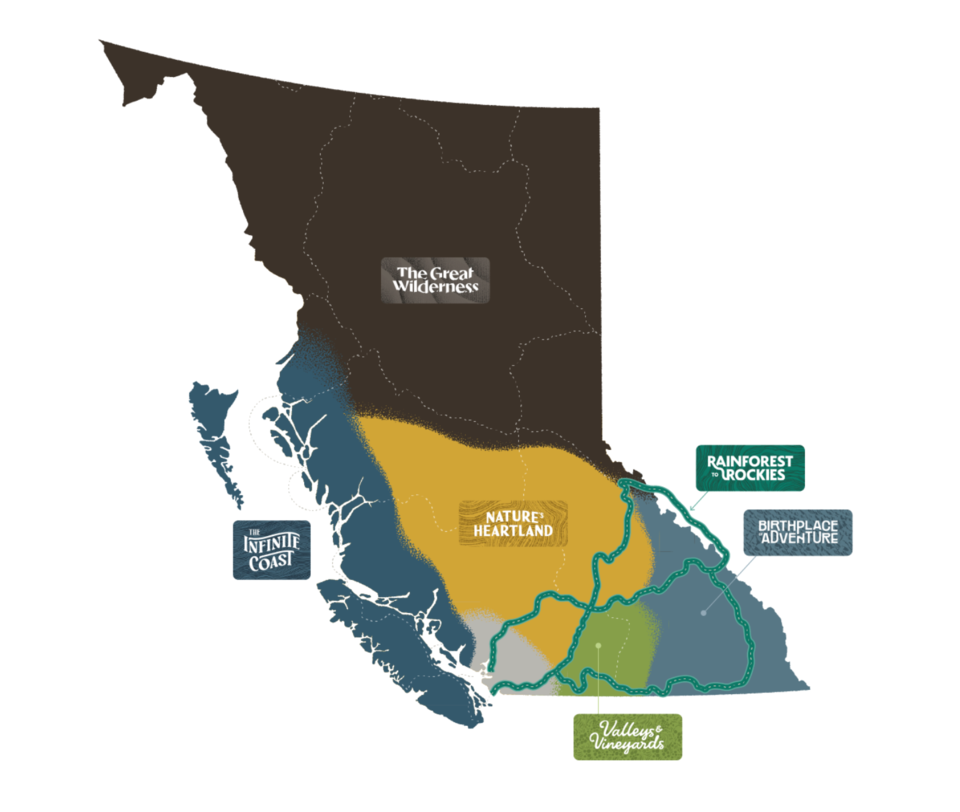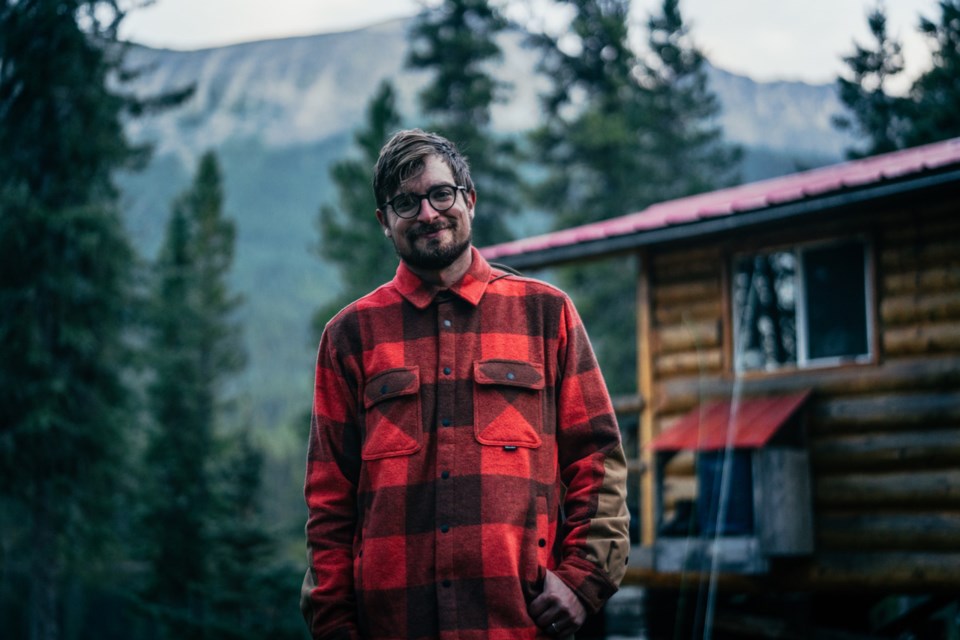British Columbia has proven itself to be a magnet for tourists, but one problem for the industry is that visitors tend to arrive during peak seasons.
They also cluster in the province’s tourism hot spots: Metro Vancouver, Victoria, Whistler and the Okanagan.
The province’s destination tourism marketer, Destination British Columbia, is attempting to change this by creating and using niche sub-brands that operate under the province’s well-known slogan, Super Natural British Columbia.
Two of these new sub-brands were released last year: Rainforest to Rockies and The Great Wilderness.
On June 4, the tourism marketer that operates on a $59 million annual budget launched four additional sub-brands: The Infinite Coast, Nature’s Heartland, Birthplace of Adventure, and Valleys and Vineyards.
The idea is not so much that international travellers will hear these sub-brands’ wording and be immediately inspired to visit the province. Instead, the six sub-brands’ marketing materials are set to target, at least initially, travel agents and group-tour operators, and help them distinguish between different geographic areas in B.C. and understand the kinds of attractions that exist within each one.
Destination BC staff help agents and guides create and sell potential itineraries for their clients, Destination BC director of global brand strategy Leah Poulton explained to BIV.
“We help them with product knowledge, training and education,” she said. “We’ll be building toolkits for the travel trade, and have other supports like that to make sure that they have the information.”
Destination BC’s sub-brands target areas outside of Metro Vancouver, although the Rainforest to Rockies sub-brand follows highways from the Pacific Ocean through to the Rocky Mountains.
The tourism marketer categorizes attractions under each siloed sub-brand so each one has specific potential itineraries.
The Britannia Mine Museum, just off the coast on the Sea-To-Sky Highway, is in the Rainforest to Rockies silo, said Tamsyn Jenkins, the museum’s sales and marketing manager.
She likes the idea of the new sub-brands because, she said, it helps visitors plan activities.
“We are able to associate with the Rainforest to Rockies brand, and as that gets more well-known, we will be popping up when people are researching and looking for that,” she said.
“We can leverage that within our website and on our brochures, so we become known for being on that route.”
The museum has already been using the Rainforest to Rockies tagline in its social media and on pamphlets that it had printed last year, she added.
“It’s a great way of geographically marketing the province, with the different landscapes, the nature and features of each region,” said Jenkins.
“When you’re looking at promoting B.C. to the global market, it gives a better visual for people to understand our regions.”

Daniel Schildknecht, who co-owns Northern Rockies Adventures, based near Muncho Lake on the Alaska Highway, similarly likes the new brand concepts.
He told BIV that his venture includes four planes, a lodge, nearby cabins and a recreational vehicle park.
About 14,000 people stayed at his facilities last year. He also had about 140 guests use his flight services, which includes a 135-minute flight from the Pitt Meadows Regional Airport.
He launched those flights in 2022 and has seen passenger growth jump by about 20 per cent each year, he said.
Newer tours that take visitors into the sky during northern lights displays are also popular, he added.
“In the past, most travellers, and even travel agents, focused on Vancouver, Vancouver Island and Whistler products as well as some in the Okanagan. That left the majority of B.C. unexplored, which is a real shame as B.C. has so much to offer,” he said.
“The branding of the Great Wilderness really sets the tone for us. This is a huge untouched land. It’s not like the Valleys and Vineyards of the Okanagan, which is a brand they just launched. Or even the Infinite Coast, which is Vancouver Island. We are the Great Wilderness and saying that is very beneficial for visitors if they want to see massive wilderness.”
While Schildknecht has heard industry insiders use the Great Wilderness tagline at conferences, he said he has yet to hear that term from visitors.
He thinks that may change if the sub-brands gain traction.

B.C. marketing campaigns increasingly focus on international markets
While the U.S. is by far the biggest source of international visitors to B.C., tourism marketers spend more dollars and time marketing B.C. to other international markets.
Destination BC’s director of partner and market development Meredith Moll estimated to BIV that less than one quarter of Destination BC’s marketing dollars aimed at international visitors are spent in the U.S. “because it’s only one of our six key global markets.”
When spending is funnelled into the U.S. it is done primarily in California, she added.
Most Destination BC mostly spends its marketing dollars on digital channels, such as on social media, as opposed to physical billboards.
“Specifically, the U.K., Germany, Australia, China and Mexico, as well as the U.S., are our key global markets where we really focus our efforts and our marketing spend,” she said.
This has been the case for a while, she said, so it is not a response to geopolitics, or an attempt to capitalize on anti-American sentiment in parts of Europe due to animosity with U.S. President Donald Trump and his tariff policies.
No matter how much money the tourism marketer spends in far-flung international markets, the reality is that the U.S. will continue to be the biggest single market for B.C.’s tourism sector.
Travellers visit nearby places because it is cheaper and faster.
Of the nearly 5.38 million international visitors who entered Canada through B.C. last year and stayed at least one night, close to 3.59 million — or 66.7 per cent — were Americans.
And Americans’ share of international visitors is increasing.
The number of U.S. visitors to Canada who entered through B.C. ports and stayed overnight in 2024 was up 7.6 per cent from 2023. That was higher than the 7.3-per-cent overall growth rate for international visitors.
The trend of U.S. visitor growth outpacing overall visitor growth continued in the first quarter of this year, with American overnight visits to Canada through B.C. rising 2.4 per cent year-over-year to nearly 615,000. That compared with an overall 1.1-per-cent decline, to nearly 887,000 international overnight visitors who entered Canada through B.C. year-over-year in that same time period.
Europeans plan trips much further in advance than do Americans, according to Moll and other industry advocates, such as British Columbia Tourism Industry Association CEO Walt Judas.
That means that the effect of European visitors deciding to pivot trips to be in Canada instead of the U.S. could be in its early stages.
“People are looking at Canada as an alternative,” Judas told BIV.
He said he has heard from industry partners that this is the case for Europeans as it is for Mexicans.
If the number of Mexicans visiting B.C. does rise it will buck a steep downward trend in visits that started in March 2024, after the Canadian government suddenly announced in late February of that year that most Mexicans would immediately need visas to enter Canada.
Visits by Mexicans to Canada via B.C. fell 20.3 per cent in 2024 year-over-year, to nearly 165,000. That trend continued in the first quarter of this year, with just over 36,000 Mexican travellers visiting Canada through B.C. That is 28.1 per cent fewer visitors than in the first quarter of 2024.
Air Canada and Flair Airlines have announced new routes to Mexico out of Vancouver International Airport (YVR), and they plan to increase flight frequency this winter.
Australia may be the region with the most promise for tourist growth.
Canada and Australia last year signed an Open Skies agreement that allows those countries’ airlines starting on January 1 the ability to fly an unlimited number of non-stop flights to any points within the other country.
Qantas Airways Ltd. earlier this month announced its plan to increase non-stop service between YVR and Sydney, Australia in January to daily, up from three times per week. It then plans to fly that route four times per week in February and March.



